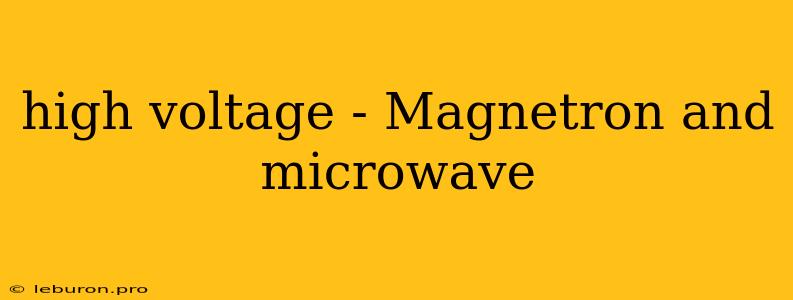The realm of high-voltage electronics is home to remarkable devices capable of harnessing and manipulating powerful electromagnetic forces. Among these is the magnetron, a fascinating device that plays a pivotal role in the generation of microwaves, the invisible waves that power our ovens and drive countless applications in telecommunications, radar, and scientific research. This article delves into the captivating world of magnetrons, exploring their principles of operation, the role of high voltage in their function, and their profound impact on modern technology.
Unveiling the Mystery: Inside the Magnetron
At its core, a magnetron is a vacuum tube designed to convert electrical energy into microwave radiation. The heart of the magnetron lies in its unique construction, featuring a cylindrical anode with a series of resonant cavities surrounding a central cathode. The magic happens when high voltage is applied between the anode and cathode, setting the stage for a captivating interplay of electric and magnetic fields.
The Dance of Electrons: How Magnetrons Work
The journey begins with the emission of electrons from the cathode. These electrons, propelled by the high voltage, embark on a spiraling trajectory towards the anode. However, their path is not straightforward. A strong magnetic field, generated by permanent magnets or electromagnets, is strategically applied perpendicular to the electron flow. This magnetic field bends the electron trajectories, forcing them into a circular motion around the cathode.
Harnessing the Power of Resonance: The Role of Cavities
The resonant cavities surrounding the anode play a critical role in the generation of microwaves. These cavities act as resonators, tuned to specific frequencies. As the electrons whirl around the cathode, their motion creates oscillating electromagnetic fields. These fields, coupled with the resonant cavities, amplify and concentrate the microwave energy.
The High-Voltage Connection: A Crucial Element
High voltage is the driving force behind magnetron operation. It provides the electrical potential needed to accelerate electrons from the cathode towards the anode. The magnitude of the high voltage directly influences the energy and power output of the generated microwaves. Higher voltages lead to greater electron velocities and more potent microwave signals.
The Importance of High Voltage in Magnetron Operation
High voltage plays a crucial role in magnetron operation, influencing various aspects of their performance:
- Electron Emission: High voltage provides the necessary potential difference for thermionic emission, where heat is used to liberate electrons from the cathode.
- Electron Velocity: The high voltage accelerates electrons, granting them the energy needed to interact with the resonant cavities and generate microwaves.
- Microwave Power: The high voltage directly correlates with the microwave power output. Higher voltages lead to greater electron velocities and more powerful microwave signals.
- Operating Frequency: The operating frequency of a magnetron is determined by the dimensions and configuration of the resonant cavities and the strength of the magnetic field. However, the high voltage also indirectly affects the operating frequency through its influence on the electron velocity and the interaction with the cavities.
Applications of Magnetrons: From Microwaves to Radar
Magnetrons have found extensive applications in various fields, driven by their ability to efficiently generate powerful microwave radiation:
- Microwave Ovens: The ubiquitous microwave oven harnesses the power of magnetrons to heat food quickly and efficiently.
- Radar Systems: Magnetrons are the workhorses behind radar systems, used in aviation, meteorology, and defense applications to detect and track objects by emitting and receiving microwave signals.
- Industrial Heating: Magnetrons find applications in industrial processes like heating, drying, and curing materials.
- Scientific Research: Magnetrons are essential tools in scientific research, employed in fields like spectroscopy, particle physics, and materials science.
Conclusion
The magnetron, a testament to the ingenuity of electrical engineering, stands as a remarkable device capable of converting electrical energy into microwave radiation. High voltage plays a pivotal role in its operation, driving electron emission, accelerating electrons, and directly influencing microwave power output. From our kitchens to the skies above, magnetrons are indispensable tools in our modern world, shaping countless technologies and making microwave energy an integral part of our daily lives.
